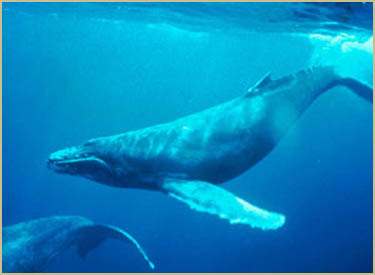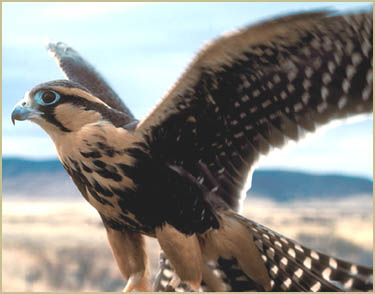|
NWHS
#011
July 23,
2006
Dear NWHS Supporter,
Welcome to issue #011 of the NWHS E-Newsletter. We thank
all subscribers for allowing us into your email inbox.
Please feel free to forward this email to others that are
interested in wildlife. If you enjoy this
newsletter, invite others to sign up.
You may visit the National Wildlife Humane Society's
website at: http://www.humanewildlife.org
More NWHS news can be viewed on our site at:
Please refrain from replying directly
back to us from this Newsletter. If you wish to email us,
concerning this Newsletter, or any other matter, please do so
at:
If you see a current and interesting
wildlife story, feel free to send us a link (to the info@
email address) to share with the other
subscribers.
 Humpback
Whale
Humpback
Whale
2 Entangled Whales Freed Off Maine
Coast
July 17,
2006 — Associated Press
BAR HARBOR,
Maine - Two humpback whales that
became entangled in marine gear off the coasts of Maine and
Massachusetts were freed by whale rescue teams, officials
said.
People aboard a whale
watch boat spotted one distressed whale on Saturday about 15
nautical miles southeast of Mount Desert Island. Marine gear
had cut deep into the whale's head, according to the
Provincetown Center for Coastal Studies in Massachusetts.
When the whale moved
close enough to the surface Sunday, a rescue team aboard a
17-foot inflatable boat cut the line with a knife mounted on a
pole, the center said. The entangling gear dropped free and
the whale disappeared into the fog.
A second rescue team
freed another humpback whale that had been entangled in gear
about 150 miles away off the Massachusetts coast, officials
with the coastal studies center said Sunday.
Humpback whales are
listed as endangered species in the United States. About
12,000 humpbacks are estimated to live in the North Atlantic,
with 900 feeding seasonally off the Northeast coast of the
U.S., according to the center.
Entanglements are a
leading cause of whale deaths. Boat strikes are also a threat
to humpback whales, which are an endangered
species.
You
may visit Provincetown Center for Coastal Studies website
at: http://www.coastalstudies.org
Source: Associated Press
 Aplomado
Falcon
Aplomado
Falcon
Falcons Get Glimpse of New Texas
Habitat
By
Alicia A. Caldwell, Associated Press
VAN HORN, Texas -
After living in cardboard U-Haul boxes for two days, 28
endangered North American aplomado falcons got a glimpse of
their new home in the rugged West Texas desert Tuesday.
Chirping like hungry seagulls, the birds flapped their
narrow wings and fluttered around the boxes lined with straw
and the remains of Japanese quail, the snack their handlers
fed them during the 1,360-mile ride from Boise, Idaho, in the
back of a minivan. Groups of the birds were lifted into small
wooden boxes that will be home until they get their first shot
at flight in about a week.
Part of the nearly
two-decade-old Peregrine Fund plan to return the birds to
their natural habitat, 126 aplomado falcons are to be released
in about 10 West Texas locations this year. The fund started
as an effort to replenish peregrine falcons, which has
succeeded.
The aplomado falcons -- 12 inches to 16
inches long with a wingspan from 2 1/2 feet to 3 feet --
disappeared from Texas, New Mexico and Arizona about 50 years
ago, and raptor biologist Bill Heinrich said it's unclear why.
Now Heinrich hopes there are enough survivors to mate
and revitalize a species listed as endangered since 1986, but
he only expects half of those released this year to make it.
When they reach 40 weeks and leave the "hack box," a white
plywood structure protecting them from roaming cattle and
other prey by a narrow strip of electrified tape, the aplomado
falcons will have to learn to fly and hunt.
"Sometimes
they won't be a good enough hunter and will starve to death,"
Heinrich said, adding that others may become prey themselves
while learning how to survive.
First brought back to
South Texas in 1995, the aplomado falcons are no longer
released in that area because dozens of pairs are nesting
there, Heinrich said. West Texas releases started in 2002, and
researchers should be able to determine if they were
successful within months.
"They don't start mating for
three or four years, so it didn't make sense to track them,"
Heinrich said.
Now monitors will keep tabs on the
birds, each marked with ankle bracelets from Heinrich's group
and the Texas Parks and Wildlife Department, to get a count of
how many survive and stay in the area.
Biologists have
been trying to bring the falcons back to the open desert for
nearly 20 years. But the effort didn't gain enough support
until 1999, when the U.S. Fish and Wildlife Service
implemented a "Safe Harbor" program that guaranteed private
landowners would not be responsible for accidental damage to
habitats for endangered species.
Jackie Means, whose
family owns and operates the Moon Ranch, one of the sites
where birds were released Tuesday, said her family would have
been hesitant to let Heinrich bring the birds to their
88,000-acre cattle ranch without the federal program.
"From the get-go we have been interested in
participating," Means said. "But we would have had a really
hard time without Safe Harbor."
Bob Cook, executive
director of the Texas Parks and Wildlife Department, said the
1999 federal law was the best thing that could have happened
for wildlife conservationists in Texas.
"It encourages
people not only to provide and protect good habitat, but it
protects them too," Cook said.
Heinrich said the
restoration program may soon extend to New Mexico, possibly
followed by Arizona. It is likely to take a decade for the
aplomado falcon to be removed from the endangered list,
Heinrich said.
Source: Associated
Press
World's Tiger Habitat Said Down 40
Percent
By
Michael Casey, Associated Press
BANGKOK,
Thailand - Tiger habitats worldwide have shrunk 40
percent in the past decade and their survival depends on
cracking down on poaching, working to reduce conflicts with
humans, and protecting key ranges, according to a study
released Thursday.
The worldwide tiger population has
steadily declined to about 7,500 globally, and the big cats
continue to face a myriad of threats -- including the trade in
tiger parts to meet demand for traditional medicines in China
and Southeast Asia.
Tigers now reside in only 7
percent of their historic range -- 40 percent less than a
decade ago, the World Wildlife Fund said.
The study by
a coalition of conservation groups identified for the first
time 76 areas, mostly in Asia, that have the best chance of
supporting tiger populations.
"Many important areas
have been overlooked for funding, largely because there has
been no method to systematically identify areas of high
conservation potential," the study said.
About half of
the 76 areas can support 100 tigers and "offer excellent
opportunities for the recovery of wild tiger populations."
Researchers are focusing on a few key regions in
India, Russia's far east and parts of Southeast Asia. Tiger
breeding areas must be protected and efforts to link different
tiger habitats need to be improved, the study said.
"We have learned many important lessons over the last
10 years, and this study provides a blueprint for scientists
and the countries that hold the key for the tigers' survival,"
said Mahendra Shrestha, director of National Fish and Wildlife
Foundation's Save The Tiger Fund, which commissioned the
study.
Conservation efforts so far have helped
stabilize certain tiger populations, but many initiatives were
"ad hoc" and "did little to stem the crisis," the study found.
John Robinson of the Wildlife Conservation Society
said tiger conservation requires commitment from local groups,
governments, and international donors to "bring the species
back to all parts of its biological range."
Source: Associated
Press |
|
|
Tell Friends About:
The National
Wildlife Humane Society Click
Above Link
Or, Feel Free To Forward This
Newsletter
If you no longer wish to receive our NWHS Newsletter,
just email
us and ask to be removed. Make certain to specify the
email address you wish to be removed from the subscription
list, if different from the email used to write us.
Articles not under the National Wildlife Humane Society (NWHS) by-line, do
not necessarily reflect the opinions or policies of NWHS.
Articles not origintating from NWHS, are passed onto
interested recipients as is, and uneditied.
Privacy Policy: Your name, email address, or
any other private info will never be sold, traded, or
furnished to any other parties. Your privacy is assured, and
all info is stored offline. All subscribers' addresses are
hidden from all other subscribers and sent as "blind copies"
(BCC:).
 | | | |